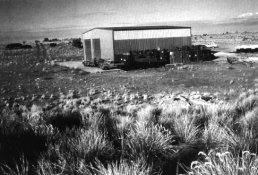
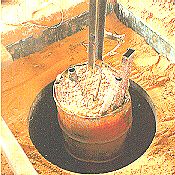
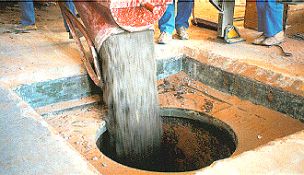



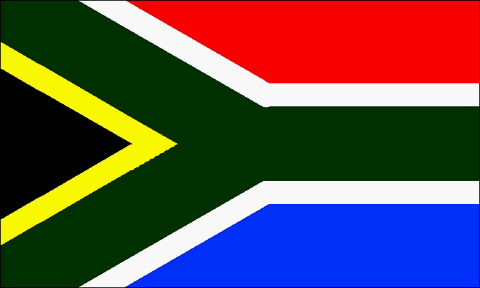



The lower cascade of the Y-Plant was commissioned by the end of 1974, and the full cascade capable of producing weapon-grade uranium began operation in March 1977. Due to the long equilibrium time of this plant, the first withdrawal of a small amount of highly enriched uranium (HEU) occurred in January 1978. During 1978 and 1979 the material produced by this plant was enriched to a "top product" of only 80%. The plant operated 7 days a week with 3 shifts, employing a total of 250 people.
The plant experienced a serious operating problem. Solid uranium tetrafluoride began being deposited in the cascade from the hexafluoride gas, and built up on filters that had been installed to trap dust from the pumping machinery. The cause appears to have been unavoidable chemical contamination inducing a reaction between the hydrogen carrier gas and the uranium hexafluoride, but it was never properly understood since the effect couldn't be reproduced in the lab. It appears to have been autocatalytic - the more uranium deposited in the system, the faster it built up. This led to a catastrophic reaction that shut down the plant from August 1979 to April 1980. Withdrawal of highly enriched uranium only resumed in July 1981. The plant was operated successfully thereafter by keeping careful logs of operation, which guided regular replacement of the filters. Over time this led to the removal of quite a lot of partially enriched uranium from the cascade of widely varying enrichment levels, reducing the plant's output of weapon grade material [Albright et al 1997; pg. 378-380].
The Y-Plant's original design capacity was 10-15,000 separative work units or SWUs per year, but improvements increased its theoretical capacity to 20,000 SWUs per year. The plant suffered from a number of operating inefficiencies that reduced the actual net separative work below this level. The loss of enriched material on filters was just one source of inefficiency, another source was inadvertent remixing of separated material in the cascade. The actual separative capacity achieved was closer to 10,000 SWUs a year than 20,000. Assuming an average output of 10-15,000 SWUs a year, with a tails assay of 0.46% (fairly high), the plant could produce 60-90 kg of 93% U-235 a year. Part of this capacity was used for low enriched uranium for the two reactors of the France-supplied Koeberg power plant (capacity 1930 MW electrical), and to supply 45% enriched material to the SAFARI 1 experimental reactor making use of partially enriched material deposited on the filters [Albright et al 1997; pg. 381-383].
In 1976 South Africa started having trouble with obtaining nuclear materials through the US. However this was because of South Africa's unsafeguarded enrichment program. The fact that South Africa conducted this work in secret from the outset, making its existence public only when further secrecy was infeasible and never submitted this program to international safeguards from its inception until 1991 is incompatible with South African claims of original peaceful intent during its early period. South African apologists for this effort overlook the fact that exactly the same work could have been conducted under safeguards - its products just couldn't be diverted for use in weapons secretly.
Despite increasing concern about South Africa's nuclear program, and the tightening of international sanctions due to its domestic and foreign policies, South Africa was able to contract in the 1970s for the construction of two large nuclear power reactors with France. These two 930 (electrical) power plants were built by Framatome and went operational at Koeberg near Capetown in 1984 and 1985.
The U.S. stopped supplying fuel for SAFARI-I in 1976, after having delivered a total of about 100 kg of weapon grade material to fuel it. The payment already tendered for the next fuel shipment was not returned by the US until 1981. The Valindaba pilot plant began supplying 45% enriched fuel for it, which required reducing its power to 5 MW. The source of this 45% enriched material was the uranium tetrafluoride impregnated filters that were removed from the upper part of the cascade -- a by-product of the plant's operational problems. The US also obstructed the shipment of fuel for the civilian Koeberg power plants, which were to be fabricated in France by Framatome. This issue was eventually resolved at some cost to South Africa, but in the end did not delay the Koeberg plants. South Africa's nuclear establishment remains bitter to this day for the sanctions imposed on their safeguarded civilian programs, in retaliation for its unsafeguarded weapons program, even though similar penalties were imposed against India and Pakistan for their weapons programs, and even though the South African program was not seriously inconvenienced by them.
Except for the SAFARI-I reactor, the need for a domestic source of enriched uranium never materialized. South Africa was never faced with a cut-off of fuel for the Koeberg reactors, but voluntarily stopped importing fuel when its own enrichment facility with sufficient capacity went on-line.
During the 1970s South Africa developed its own research reactor, a zero-power reactor called SAFARI-II built with US supplied heavy water and low-enriched uranium. This reactor was decommissioned in the early 1980s.
The seventies saw covert collaboration develop between the Israeli and South African nuclear programs, which was camouflaged by the well known collaboration between these countries on conventional arms. South Africa is known to have received technical assistance from Israel on its weapon program, in exchange for supplying Israel with 300 tons of uranium. But the extent of this assistance is not entirely clear. Several Israeli nuclear scientists, including the "Oppenheimer of Israel" Ernst David Bergmann, visited South Africa in 1967, and evidence of increasingly close relations accumulate throughout the 70s. Moshe Dayan is reported to have made a secret visit to discuss nuclear weapon cooperation in 1974, including the possibility of nuclear tests [Burrows and Windrem 1994].
PM Vorster visited Israel in April 1976 which resulted in the establishment of full diplomatic relations. Israel supplied South Africa with substantial quantities of tritium -- 30 grams, in 12 separate shipments in 1977-78, in exchange for an initial supply of 50 tons of natural uranium (eventually to total 600 tons) [Burrows and Windrem, 1994; pp. 451]. Israel is believed to have provided technical advice about bomb design although details about this are lacking.
In 1977 the nuclear explosives program officially shifted to focusing on the development of a strategic nuclear capability - the development of weapons. Waldo Stumpf describes the points of the strategy approved by Defense Minister PW Botha and Prime MInister Vorster in April 1978:
Phase 1: Strategic uncertainty in which the nuclear deterrent capability will not be acknowledged or denied.[Stumpf 1995].
Phase 2: Should South African territory be threatened, for example, by the Warsaw Pact countries through the surrogate Cuban forces in Angola, covert acknowledgement to certain international powers, e.g. the USA, would be contemplated.
Phase 3: Should this partial disclosure of South Africa's capability not bring about international intervention to remove the threat, public acknowledgement or demonstration by an underground test of South Africa's capability, would be considered.
From 1974-77 the AEB carried out all of the fundamental work needed to design a gun-type uranium weapon. It developed internal ballistic and neutronic computer programs, conducted experiments to determine properties of the materials in the devices, designed and constructed a critical facility in Building 5000 at Pelindaba, and experimented with propellants for a gun-type device. The team working at Somchem tested the first full-scale model of the gun-type device using a non-fissionable natural uranium projectile in 1976. This test proved the mechanical integrity of the design[Albright 1994a].
In 1977, the AEB established its own high-security weapons research and development facilities at Pelindaba, and during that year the program was transferred from Somchem to Pelindaba. In mid-1977, the AEB produced first full-scale gun-type device prototype (as opposed to a just a ballistic test device) without an HEU core. This device -- described as "a monster" and weighing 3 tonnes - was intended as a non-weaponizable feasibility demonstrator[Albright 1994a].
 |
|
| Vastrap military base test site in the Kalahari Desert. | |
 |
 |
| Test shafts being filled in by Armscor under IAEA supervision July 1993. | |
As preparations proceeded, the US was passed information by South Africa of its intention to conduct nuclear tests. The US urged SA not to conduct the test, but kept the information secret. But in August 1977 a Soviet surveillance satellite detected these test preparations, and the Soviets notified the US of their discovery. With its cover blown, heavy diplomatic pressure was brought by the US, the Soviet Union, and France on South Africa. The French foreign minister warned on 22 August of "grave consequences" or FrenchSouth African relations. Although he did not elaborate, his statement implied that France was willing to cancel its contract for the Koeberg reactors. Upon direct instruction of the PM Vorster, the site was abandoned in August 1977 and was not revisited until 1987 when the test shafts were inspected and a corrugated iron shed with a concrete floor constructed over one of the two shafts to prepare the shaft for future testing contingencies. [Burrows and Windrem 1994], [Stumpf 1995], [Albright 1994a].
According to Stumpf, after the abandonment of the test site, cold testing of the relatively crude first-off device was never carried out. It should be noted that the use of a remote desert test for conducting an inert test of the gun-assembly mechanism is unnecessary - any location where testing of modest amounts explosives is allowed would be suitable. The decision not to test this initial prototype indicates that it was not considered essential to the program.
A second, smaller device was built in 1978 to support rapid deployment to the Kalahari site for an instrumented test as called for in Phase 3 of the deterrent strategy, should it become necessary.
Prior to the August 1979 shut down of the Y-Plant, enough HEU (of 80% enrichment) had been produced -- at least 55 kg -- to fuel a nuclear device. The HEU was fabricated into a core for the second experimental device in November 1979. This device was named Melba, and was completed in 1980. This device was used in one zero-yield test (a tests in which a chain reaction is initiated with negligible energy output) apparently in the late 1970s, the only nuclear test of the entire program [Albright 1994a].
Work began in 1979 on a larger enrichment plant - the "Z-Plant". This plant had a more advanced design with a design capacity of 300,000 SWUs per year. This plant was intended for commercial production of low enriched uranium however, and had a maximum enrichment of 3.25 percent. Due to its size this plant could not directly produce highly enriched uranium due to criticality problems, it could have considerably boosted the output of the Y-Plant though by using it LEU output as feedstock. The uranium hexafluoride plant was completed in 1986 with the capacity of producing 700 tonnes a year. The Z-Plant was commissioned in 1984 but production problems prevented commercial operation until 1988. About two-thirds of its annual capacity was required to fuel the Koeberg reactors, though from 1988 to mid-1993 these reactors consumed 95% of the total actual output (which was 734,000 SWUs) - there being few other customers. The actual production was thus about half of its rated capacity. Due to the inherent inefficiency of the vortex separation process this plant was not commercially competitive and was permanently shut down on 31 March 1995.
Responsibility for designing and building the gun type devices was reassigned to Armscor -- the state-owned Armaments Corporation (now privatized and called Denel) -- in 1979. The AEC was still responsible for providing the HEU as well as theoretical and experimental physics support - including nuclear system design and tests and health physics surveillance. A new dedicated Armscor facility for the development and manufacture of deliverable weapons was constructed 15 km east of the Pelindaba facility near Pretoria.
The site selected was in the middle of a large existing Armscor facility called Geotek. This facility was used to test all-terrain vehicles and was thus large, hilly, closed to the public, and the given to considerable activity if intermittent activity. It was well chosen location for an inconspicuous operation. This new nuclear weapon development site is called the Kentron Circle facility (or simply the Circle) and was commissioned in May 1981 and all previously manufactured hardware was transferred to this facility from the AEC facilities. This site was later renamed Advena.
The Kentron Circle facility also pursued work on lithium-6 separation for the production of tritium for possible future use in boosted devices; studies of implosion and thermonuclear technology; and research and development for the production and recovery of plutonium and tritium[Baeckmann et al 1995].
South Africa was planning a 150 MW pressurized water reactor at Gouriqua, near Mosselbay, in Cape Province to produce both plutonium and tritium. Plans for this plant were cancelled in 1985[Albright et al 1997; pg. 392].
A lingering question mark over the South African (and Israeli) nuclear programs from this time stems from the apparent detection of a low yield atmospheric nuclear explosion of unknown origin over the Indian Ocean on 22 September 1979. Due to arguments from capability and motivation Israel has always been the prime suspect, but due to its location near South Africa, South Africa's suspected (and now admitted) nuclear weapons program, and the joint nuclear and conventional weapons collaboration between these two countries, other scenarios have been offered ranging from sole South African responsibility to a joint test program. In April 1997 South African Deputy Foreign Minister Aziz Pahad made an apparent admission of culpability which attracted considerable attention. It transpired however that Pahad was merely stating a belief based on the long-standing speculation surrounding this controversy, and had no inside or additional knowledge about the event. See the Vela Incident article for full details about this event.
Examination of Valindaba production records, and accounting of the material by the IAEA after it was placed under safeguards apparently has not shown the deficit of 50-60 kg of uranium that would have been consumed in a test. In fact IAEA accounting has determined that any discrepancy is less that a "significant quantity" or SQ, which is 25 kg. The possibility of participation in a test of an Israeli device of course remains open. It is interesting though that the production of sufficient material for a test device preceded the 22 September event by only a matter of weeks.
In 1982, the Uranium Enrichment Corporation was again incorporated with the Atomic Energy Board, into a single State Corporation, the present Atomic Energy Corporation (AEC).
The first "deliverable" device ("it could be kicked out the back of a plane"), and the second device built, was ready in April 1982. This was considered a "pre-qualification device" [Albright 1994a]. The first device to be built at the new Armscor facility was completed in December 1982. This device (the third one made) was the first built to the final specifications and compatible with the standard delivery systems. Subsequent devices were built at the rate of a less than one per year, matching the production of the enrichment plant [Stumpf 1995].
 Courtesy of Mungo Poore. Click for a larger image (115 K). |
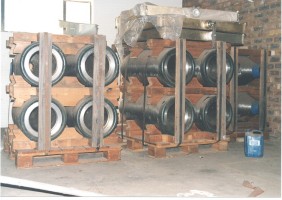 Courtesy of Mungo Poore. Click for a larger image (111 K). |
|
The casings made for the atomic bombs and stored at Advena. These are probably unused casings for new bombs, since the Chicago Tribune reported on 2 May 1999 that pieces of the casings of the actual atomic bombs were beaten into miniature, ornamental plowshares, "suitable as gifts for inspectors of the International Atomic Energy Agency". |
|
The final weapon design was a 65 cm by 1.8 m air-deliverable bomb weighing about 1000 kg. It used 55 kg of +90% enriched U-235 and had an estimated yield of 10-18 Kt (this is 1.0-1.8% efficient). This implies a very conservative and reliable, but inefficient, design. It used tungsten as a reflector. Loaded with 80% U-235 as Melba, the one (undeliverable) device was, the estimated yield was 5-9 Kt. The nuclear device was designed to function also the warhead of the (never deployed) RSA missile. In this role it would have been lighter (perhaps 750 kg), since it would have lacked the steel ballistic case of the bomb.
The weapons program had stringent safety and reliability standards, and a large proportion of the its effort went into this aspect. This led to a nearly five year delay in final acceptance of the first Armscor-built weapon due to the implementation of a rigorous engineering qualification program directed towards safety and security under a wide range of postulated storage, delivery, and accident scenarios. It was not until August 1987 that this first device completed full qualification testing and became certified for inventory. This model could be delivered by a modified Buccaneer bomber[Albright 1994a].
Only four of these fully-weaponized devices were completed. When, in November 1989, the decision was taken by the Government to stop the production of nuclear weapons, a fifth one (and the seventh by total count) was under construction. The HEU core and some non-nuclear components had been fabricated for this uncompleted weapon. This is really a maximum deliverable inventory of only 4 or 5 bombs. Presumably Melba was the designated demonstration device to be fired at Vastrap in the event that Phase 3 of the deterrent strategy was put into practice [Albright 1994a], [Baeckmann et al 1995].
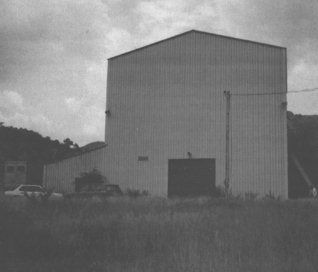
|
This is Building 5000, which sits in a valley on the southwestern portion of the Pelindaba site, away from the main complex. Building 5000, now abandoned and empty, was the critical assembly facility, where the first experimental weapon designs were assembled and where the Melba device was given its "zero-yield" test. |
Armscor emphasized the physical security of both the devices and the HEU. A special high-security vault with many smaller vaults inside was installed inside the Circle building. Access to the vault was tightly controlled.
Each nuclear device was divided into two sections, a front and back. With the HEU distributed between the two halves, the design eliminated the possibility of accidental detonation or unauthorized use. According to an Armscor official, a front and back end were never worked on simultaneously. Both ends could leave the vault at the same time only after three top ministers and the head of government inserted their separate sections of the code into the vault. No one person had the complete code[Albright 1994a].
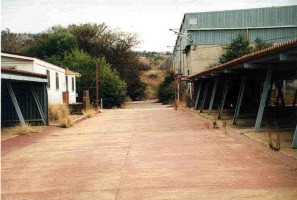 |
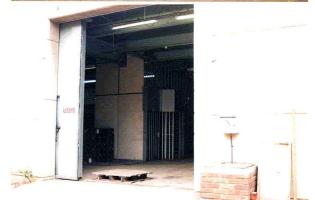 |
| The Advena Central Laboratory | Entrance to the bomb storage building at Advena. |
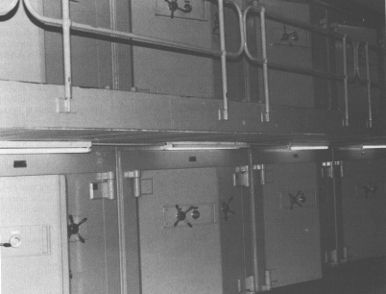 . |
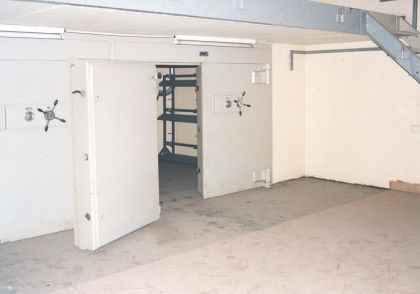 |
| The weapon storage lockers used for storing the actual assembled nuclear weapons at Advena. | |
In the early 1980s, the program employed about 100 people, of which only about 40 were directly involved in the weapons program and only about 20 actually built the devices. The rest were involved in administrative support and security. By the time the program was canceled in 1989, the work force had risen to 300, with about half directly involved in weapons work. Personnel needed top secret security clearances. Only native-born South African citizens with no other citizenship could receive the necessary security clearance.[Albright 1994a].
A review of the program in 1985 led to the three-phase deterrent strategy being reconfirmed, but the production program being capped at 7 fission gun-type devices. Only very limited work, mainly of a theoretical nature, was allowed to continue on more advanced concepts, such as implosion systems, fusion boosting, lithium-6 production, etc.
Renewed emphasis on being ready to carry our the three-phase strategy prompted the government to examine that state of the Vastrap test shafts. Reportedly Armscor built a shed over the shaft as to conceal the operation - with the military conducted target shooting at the same time to provide a plausible cover. The water pumped out of the shaft was put into containers and hauled off the site since dumping it would clearly signal that the shaft was being prepared. After removing the water, technicians lowered a specially designed inspection probe that determined that the shaft was still intact [Stumpf 1995], [Albright 1994a].
However this account does not quite hold together - building a permanent structure over the shaft was absolutely guaranteed to be noticed, and to be connected with preparations to make the shaft ready for use. Further the construction of a concrete floor, which would be very desirable to support a rig for lowering a 1000 kg device, suggests that shed was intended as a work area for conducting a test. It may be that South Africa wanted to conceal precisely what they were up to, but the operation seems calculated to have sent a clear signal to the US and Soviet Union.
During the 1980s a collaborative effort started with Israel on missile development. Israel had already fielded its first ballistic missile, the Jericho-1, and was developing a more advanced version with greater range, the 1500 km Jericho-2. Israel worked with South Africa during the Jericho-2's development to assist them in producing their own family of missiles based on the Jericho-2. In addition to the uranium supply South Africa provided, Israel's own missile program probably benefited in being able to share costs and resources during development, and from being able to use South African test facilities in particular the excellent Overberg Test Range established in 1986 near Arniston (also called Waenhuiskrans), a fishing town 200 km east of Cape Town. With Israel's help this site was developed into a sophisticated test range, essentially a duplicate of the Palmichim test range in Israel. This site was used first used for a launch of the South African Jericho-derived missile on 5 July 1989. This missile, due to the location where its first test was observed, has been termed the "Arniston", but the missile family was known in South Africa as the RSA (for Republic of South Africa). A family of four military vehicles (RSA-1 through 4) were developed, in addition to work on a space launch variant - the RSA-5b. The fully weaponized nuclear device developed by Armscor was designed to be deliverable by both aircraft delivered bomb, and as a warhead for the RSA. The military missile program was cancelled in 1992, probably before reaching operational status, followed by the space program a year later [Burrows and Windrem 1994; 446-448].
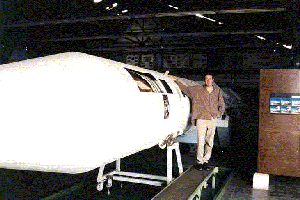 |
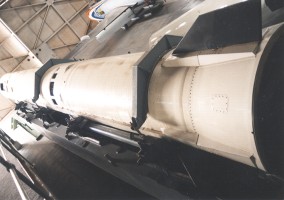 |
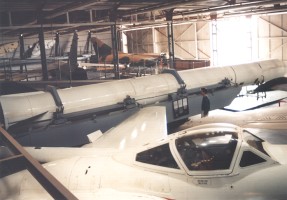 |
| RSA ("Arniston") launch vehicle on display in South Africa. | ||
Toward the end of the eighties a major expansion of the facilities at Advena were planned. A new complex to be called Advena Central Laboratories was started near the original Circle facility. This complex was intended to have a cold implosion test facility (natural uranium core, no nuclear reaction) which was felt to be essential for proving an implosion design. The implosion facility alone was estimated at $3.5 million and was never built. Implosion designs would have halved the amount of material needed per bomb, and thus doubled their arsenal, while increasing the yield.
The total cost of the new complex and upgrading the Circle building was 36 million rand, or about $10 million at the 1994 exchange rate. In addition to work on implosion and boosted designs, it would have been used to upgrade the gun devices by 2000, and would have had an expanded production capacity of up to three weapons a year.
Advena had also investigated using tritium to boost its existing weapons, but no plans to do so were ever approved. The yield would have been increased to 100 Kt (10% efficiency). Since it now offers custom explosive lens products for commercial and military use, it is apparent that South Africa has mastered the necessary technologies for producing efficient implosion bombs.
The plans for expansion were abandoned in 1989.
Estimates of the cost of South Africa's nuclear weapons program have spanned a wide range. Waldo Stumpf of the AEC estimated that at 1993 exchange rates the capital cost of the Y-Plant was $60 million, with annual operating costs averaging $14 million for a total of $240 million or so.
By the end of the weapons program the annual operating expenditures were about 20-25 million rand, or about $5.9-7.4 million at 1995's exchange rate. In the early 1980s, the annual budget was about 10 million rand, or about $2.9 million. This suggests a weapon production cost on the order of $70 million.
This suggested program cost of around $310 million (early 1990s exchange and inflation rates), which does not include any costs involved in developing the enrichment technology, can be compared to the actual appropriations on the AEC which totaled around $5 billion. It is quite possible that a great deal of additional infrastructure and support costs used by the weapon program is also not included in the $310 million, and thus the actual expenditures bringing it to fruition required were substantially larger.





